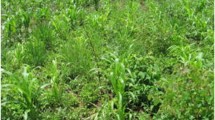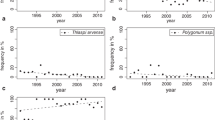Abstract
Weed maps created late in the growing season are potentially useful in regions where late maturing weeds are problematic and need to be controlled before they produce seed. The objectives of this study were to (1) spatially characterize the population dynamics of predominant weed species and apply this information into quantifying the effect of treated and untreated weed infestations on wheat (Triticum aestivum L.) yields and (2) evaluate potential herbicide savings with post-harvest site-specific treatments. Multi-year grain yield and weed data were acquired at harvest in each of four years (2015–18) within a dryland production field (9.2 ha) in eastern Oregon. Abundance of weed species (2015) and percent cover of weed species (2016, 2017 and 2018) were visually estimated on a square grid based on dividing the field into 7-m2 cells. Spatial patterns in the weed community were subject to rapid change and depended on year, crop and weed control strategy. While tumble mustard (Sisymbrium altissimum) was the most predominant and competitive species, the spatial distribution of this weed and that of other species varied each year. Tumble mustard and prickly lettuce (Lactuca serriola) were equally problematic in spring wheat and winter wheat whereas Russian thistle (Salsola tragus) was problematic in spring wheat and downy brome (Bromus tectorum) in winter wheat. Potential savings from site-specific herbicide application varied from 10 to 95% based on percentage of field infested. Weed maps at harvest are useful for studying weed dynamics, identifying potentially herbicide-resistant weeds and planning site-specific weed management. Combined with yield maps, weed maps at harvest are also useful for explaining crop yield variability that is associated with weed competition and weed control in furtherance of integrated weed management strategies.






Similar content being viewed by others
References
Alcocer-Ruthling, M., Thill, D. C., & Mallory-Smith, C. A. (1992). Monitoring the occurrence of sulfonylurea-resistant prickly lettuce (Lactuca serriola). Weed Technology, 6, 437–440.
Allen, M. F., Allen, E. B., & Friese, C. F. (1988). Responses of the non-mycotrophic plant Salsola kali to invasion by vesicular-arbuscular mycorrhizal fungi. New Phytology, 111, 45–49.
Bajwa, A. A., Walsh, M., & Chauhan, B. S. (2017). Weed management using crop competition in Australia. Crop Protection, 95, 8–13.
Barroso, J., Fernández-Quintanilla, C., Maxwell, B. D., & Rew, L. J. (2004). Simulating the effects of weed spatial pattern and resolution of mapping and spraying on economics of site-specific management. Weed Research, 44, 460–468.
Barroso, J., & Gourlie, J. A. (2016). Problematic weed species in Northeast Oregon. Oregon Wheat Magazine, pp. 10–11.
Barroso, J., Gourlie, J. A., Lutcher, L. K., Mingyang Liuc, M., & Mallory-Smith, C. A. (2018). Identification of glyphosate resistance in Salsola tragus in north-eastern Oregon. Pest Management Science, 74, 1089–1093.
Barroso, J., McCallum, J., & Long, D. (2017). Optical sensing of weed infestations at harvest. Sensors, 17, 1–12. https://doi.org/10.3390/s17102381
Barroso, J., Ruiz, D., Fernández-Quintanilla, C., Leguizamón, E. S., Hernáiz, P., Ribeiro, A., et al. (2005). Comparison of sampling methodologies for site-specific management of Avena sterilis. Weed Research, 45, 165–174.
Beckie, H. J., Ashworth, M. B., & Flower, K. C. (2019). Herbicide resistance management: Recent developments and trends. Plants 8(6), 161. https://doi.org/10.3390/plants8060161
Blackshaw, R. E. (1993). Downy Brome (Bromus tectorum) density and relative time of emergence affects interference in winter wheat (Triticum aestivum). Weed Science, 41, 551–556.
Blanco-Moreno, J. M., Chamorro, L., Izquierdo, J., Masalles, R. M., & Sans, F. X. (2008). Modelling within-field spatial variability of crop biomass - weed density relationships using geographically weighted regression. Weed Research, 48, 512–522.
Brim-DeForest, W. B., Al-Khatib, K., & Fischer, A. J. (2017). Predicting yield losses in rice mixed-weed species infestations in California. Weed Science, 65, 61–72.
Brunsdon, C., Fotheringham, A. S., & Charlton, M. E. (1996). Geographically weighted regression: A method for exploring spatial nonstationarity. Geographical Analysis, 28, 281–298.
Burke, I. C., Yenish, J. P., Pittmann, D., & Gallagher, R. S. (2009). Resistance of a prickly lettuce (Lactuca serriola) biotype to 2,4-D. Weed Technology, 23, 586–591.
Castillejo-Gonzalez, I. L., de Castro, A. I., Jurado-Expósito, M., Pena, J. M., García-Ferrer, A., López-Granados, F., et al. (2019). Assessment of the persistence of Avena sterilis L. patches in wheat fields for site-specific sustainable management. Agronomy-Basel, 9(1), 30. https://doi.org/10.3390/agronomy9010030
Chepil, W. S. (1946). Germination of weed seeds. 1. Longevity, periodicity of germination and vitality of seeds in cultivated soil. Scientific Agriculture, 26, 307–346.
Dicke, D., Gerhards, R., Buchse, A., & Hurle, K. (2007). Modeling spatial and temporal dynamics of Chenopodium album L. under the influence of site-specific weed control. Crop Protection, 26, 206–211.
Esposito, M., Crimaldi, M., Cirillo, V., Sarghini, F., & Maggio, A. (2021). Drone and sensor technology for sustainable weed management: a review. Chemical and Biological Technologies in Agriculture, 8(1), Article Number: 18. https://doi.org/10.1186/s40538-021-00217-8.
Fernández-Quintanilla, C., Peña, J. M., Andújar, D., Dorado, J., Ribeiro, A., & López-Granados, F. (2018). Is the current state of the art of weed monitoring suitable for site-specific weed management in arable crops? Weed Research, 58, 259–272.
Freckleton, R. P., Sutherland, W. J., Watkinson, A. R., & Stephens, P. A. (2008). Modelling the effects of management on population dynamics: some lessons from annual weeds. Journal of Applied Ecology, 45, 1050–1058.
Gaba, S., Caneill, J., Nicolardot, B., Perronne, R., & Bretagnolle, V. (2018). Crop competition in winter wheat has a higher potential than farming practices to regulate weeds. Ecosphere, 9(10), 1–17. https://doi.org/10.1002/ecs2.2413
González-Andújar, J. L., & Bastida, F. (2018). Modeling the population dynamics of a community of two grass weeds of winter wheat in a Mediterranean Area. International Journal of Plant Production, 12, 219–223.
Heap, I. (2019). The international survey of herbicide resistant weeds. www.weedscience.com. Accessed 18 Oct 2019.
Hooftman, D. A. P., Oostermeijer, J. G. B., & Den Nijs, J. C. M. (2006). Invasive behaviour of Lactuca serriola (Asteraceae) in the Netherlands: Spatial distribution and ecological amplitude. Basic Applied Ecology, 7(6), 507–519.
Hulbert, L. C. (1955). Ecological studies of Bromus tectorum and other annual bromegrasses. Ecological Monographs, 25, 181–213.
Jeschke, M. R., Stoltenberg, D. E., Kegode, G. O., Sprague, C. L., Knezevic, S. Z., Hock, S. M., et al. (2011). Predicted soybean yield loss as affected by emergence time of mixed-species weed communities. Weed Science, 59, 416–423.
Kumar, V., Jha, P., Jugulam, M., Yadav, R., & Stahlman, P. W. (2019). Herbicide-Resistant Kochia (Bassia scoparia) in North America: A Review. Weed Science, 67, 4–15.
Lamb, D. W., Frazier, P., & Adams, P. (2008). Improving pathways to adoption: Putting the right P’s in precision agriculture. Computers and Electronics in Agriculture, 61, 4–9.
Lati, R. N., Rasmussen, J., Andujar, D., Dorado, J., Berge, T. W., Wellhausen, C., et al. (2021). Site-specific weed management-constraints and opportunities for the weed research community: Insights from a workshop. Weed Research. https://doi.org/10.1111/wre.12469
Long, D. S., & McCallum, J. D. (2015). On-combine, multi-sensor data collection for post-harvest assessment of environmental stress in wheat. Precision Agriculture, 16, 492–504.
López-Granados, F. (2011). Weed detection for site-specific weed management: mapping and real-time approaches. Weed Research, 51, 1–11.
López-Granados, F., Torres-Sánchez, J., Serrano-Perez, A., Castro, A. I., Mesas-Carrascosa, F. J., Peña, J. M., et al. (2016). Early season weed mapping in sunflower using UAV technology: variability of herbicide treatment maps against weed thresholds. Precision Agriculture, 17, 183–199.
Lotz, L. A. P., Christensen, S., Cloutier, D., Quintanilla, C. F., Legere, A., Lemieux, C., et al. (1996). Prediction of the competitive effects of weeds on crop yields based on the relative leaf area of weeds. Weed Research, 36, 93–101.
Pena, J. M., Torres-Sanchez, J., Isabel de Castro, A., Kelly, M., & Lopez-Granados, F. (2013). Weed mapping in early-season maize fields using object-based analysis of unmanned aerial vehicle (UAV) images. Plos One. https://doi.org/10.1371/journal.pone.0077151
Rasmussen, J., Azim, S., Nielsen, J., Mikkelsen, B. F., Hørfarter, R., & Christensen, S. (2020). A new method to estimate the spatial correlation between planned and actual patch spraying of herbicides. Precision Agriculture, 21, 713–728.
Rasmussen, J., Nielsen, J., Streibig, J. C., Jensen, J. E., Pedersen, K. S., & Olsen, S. I. (2019). Pre-harvest weed mapping of Cirsium arvense in wheat and barley with off-the-shelf UAVs. Precision Agriculture, 20, 983–999.
Renka, R. J. (1988). Multivariate interpolation of large sets of scattered data. ACM Transactions in Mathematical Software, 14, 139–148.
Ritter, C., Dicke, D., Weis, M., Oebel, H., Piepho, H. P., Büchse, A., et al. (2008). An on-farm approach to quantify yield variation and to derive decision rules for site-specific weed management. Precision Agriculture, 9, 133–146.
Rodriguez, J. A., Zuger, R. J., Hauvermale, A. L., & Burke, I. C. (2018). Cross resistance patterns in multiple ALS-resistant downy brome (Bromus tectorum L.) Accessions from Washington. In Proceedings of the Western Society of Weed Science, 71, 17–18. http://www.wsweedscience.org/wp-content/uploads/WSWS_2018_Proceedings-Corrected-1.pdf. Accessed 22 July 2020.
Royer, F., & Dickinson, R. (1999). Weeds of the Northern US and Canada (pp. 44–45). The University of Alberta Press and Lone Pine Publishing.
Rstudio Team (2015). Integrated Development for R. RStudio, Inc., Boston, MA. http://www.rstudio.com/. Accessed 8 Aug 2019.
Ruixiu, S., Thomasson, J. A., Hanks, J., & Wooten, J. (2008). Ground-based system for weed mapping in cotton. Computers and Electronics in Agriculture, 60, 31–38.
Rydrych, D. J., & Muzik, T. J. (1968). Downy brome competition and control in dryland wheat. Agronomy Journal, 60, 279–280.
Schillinger, W. F., & Young, F. L. (2000). Soil water use and growth of Russian thistle after wheat harvest. Agronomy Journal, 92, 167–172.
Sebastian, D. J., Nissen, S. J., Sebastian, J. R., & Beck, K. G. (2017). Seed bank depletion: The key to long-term downy brome (Bromus tectorum l.) management. Rangeland Ecology and Management, 70(4), 477–483.
Stahlman, P. W., & Miller, S. D. (1990). Downy brome (Bromus tectorum) interference and economic thresholds in winter wheat (Triticum aestivum). Weed Science, 38, 224–228.
Upadhyaya, M. K., Turkington, R., & McIlvride, D. (1986). The biology of Canadian weeds. 75. Bromus tectorum L. Canadian Journal of Plant Science, 66, 689–709.
Van der Meulen, A., & Chauhan, B. S. (2017). A review of weed management in wheat using crop competition. Crop Protection, 95, 38–44.
Weaver, S., Cluncy, K., Downs, M., & Page, E. (2006). Prickly lettuce (Lactuca serriola) interference and seed production in soybeans and winter wheat. Weed Science, 54, 496–503.
Weed Science Society of America (WSSA). (1984). Composite list of weeds arranged by scientific name. Weed Science, 32(S2) (Supplement 2: Composite List of Weeds), (pp. 3–137).
Whitson, T. D., Parker, R., Cudney, D., Ball, D. A., Dewey, S. A., Morishita D. W. et al. (2009). Weeds of the West. 10th (ed.) Jackson, WY, USA: Western Society of Weed Science in Collaboration with the Western United States Land Grant Universities Cooperative Extension Services (pp.154–155).
Wicks, G. A., Burnside, O. C., & Fenster, C. R. (1971). Influence of soil type and depth of planting on downy brome seed. Weed Science, 19, 82–86.
Yorgey, G., Kantor, S., Painter, K., Roe, D., Davis, H., & Bernacchi, L. (2016). Flex cropping and precision agriculture technologies, Bill Jepsen. Farmer-to-Farmer Case Study. A Pacific Northwest Extension Publication, PNW681. Washington State University, USA.
Acknowledgements
Authors thank the Oregon Wheat Commission for partially funding this research, Jennifer Gourlie for data collection and Steve Umbarger for field harvest.
Author information
Authors and Affiliations
Corresponding author
Additional information
Publisher's Note
Springer Nature remains neutral with regard to jurisdictional claims in published maps and institutional affiliations.
Rights and permissions
About this article
Cite this article
Barroso, J., San Martin, C., McCallum, J.D. et al. Economic and management value of weed maps at harvest in semi-arid cropping systems of the US Pacific Northwest. Precision Agric 22, 1936–1951 (2021). https://doi.org/10.1007/s11119-021-09819-6
Accepted:
Published:
Issue Date:
DOI: https://doi.org/10.1007/s11119-021-09819-6




